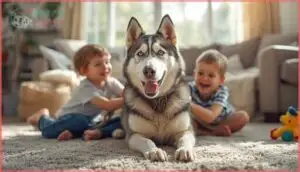This site is supported by our readers. We may earn a commission, at no cost to you, if you purchase through links.

The answer isn’t as simple as yes or no. Huskies possess a gentle, pack-oriented nature that often translates to patience with kids, yet their size, strength, and stubborn streak demand careful consideration.
Before you bring one of these impressive dogs into your family, you need to understand both their protective instincts and their potential challenges around children.
Table Of Contents
- Key Takeaways
- Are Huskies Good With Kids?
- Husky Temperament and Family Life
- Safety Tips for Kids and Huskies
- Training and Socialization Essentials
- Daily Care and Exercise Needs
- Grooming, Health, and Household Considerations
- Frequently Asked Questions (FAQs)
- Are there any age restrictions for children to be eligible for HUSKY Health?
- How can I access the HUSKY Health Nurse Helpline?
- How do I sign up for the HUSKY Health Parent Insider Newsletter?
- Can Huskies live comfortably in small apartments?
- How do Huskies behave around babies and toddlers?
- Whats the best age to adopt a Husky?
- Do Huskies get along with other family pets?
- How much does owning a Husky typically cost?
- Conclusion
Key Takeaways
- Huskies can be gentle with children but need close supervision, especially around kids under five, to prevent accidents from their strength and energy.
- Consistent training and early socialization are critical for safe, positive Husky-child relationships.
- Daily vigorous exercise and mental enrichment are must-haves to keep Huskies happy and prevent destructive behavior at home.
- Shedding, noise, and specific health needs require families to prepare for daily care and a dog-friendly home environment.
Are Huskies Good With Kids?
If you’re wondering how Huskies fit into family life, especially with kids, you’re not alone. There are a few important things to think about before bringing one home.
Let’s look at what you should know when considering a Husky for your family.
Typical Husky Temperament Around Children
When you watch a Siberian Husky with children, you’ll notice their play initiation and gentle roughhousing often set the tone for positive child-dog interaction. Thanks to high patience thresholds and protective behaviors, Huskies show considerable tolerance and stress reduction around kids.
This temperament bolsters child safety, making Huskies a solid choice for families focused on healthy dog behavior. The AKC rates them as good with children, highlighting their suitability for family life.
Age Considerations for Kids
While Huskies shine with school-age kids, infant risks and toddler safety are real concerns. Incident statistics show most husky-related injuries involve children under five, especially when supervision lapses. That’s why constant adult supervision is non-negotiable for younger kids.
Huskies are known to be highly energetic dogs, requiring ample exercise which can sometimes lead to unintentional harm during play with small children.
For families, Huskies and child safety go hand-in-hand with age-appropriate boundaries, especially when introducing dogs and kids to daily life.
Pros and Cons for Families
Understanding husky family compatibility means weighing both sides honestly. Loyalty and bonding run deep—over 70% of families report excellent child tolerance.
But exercise demands are real: 40-60 minutes daily, minimum. Add in grooming impact from year-round shedding, training needs for that independent streak, and noise levels that might wake babies.
When introducing dogs and kids, health factors and dog behavior and child interaction matter as much as affection does.
Husky Temperament and Family Life
Understanding your husky’s natural personality helps you prepare for life with this breed. These dogs bring a unique mix of traits that shape how they interact with your family.
Let’s look at three key aspects of the husky temperament that matter most when you have kids at home.
Affection and Social Traits
If you’re wondering whether Siberian Husky temperament fits your household, their social adaptability stands out. Over 94% of owners report their dogs bond with every family member, not just one person. Here’s what makes them wonderful family pets:
- Bonding Patterns: They see your household as their pack
- Friendliness Levels: 88% are rated “friendly to all guests”
- Affection Display: 82% show daily physical affection
- Emotional Response: 72% react sensitively to family mood shifts
- Child-Dog Interaction: 75% actively comfort distressed family members
This genuine social nature, combined with their patience around children, makes them reliably good with kids when properly introduced.
Energy Levels and Playfulness
Expect a tireless playmate when you bring home a Husky. These energetic dogs need 1–2 hours of vigorous exercise daily, and 92% of owners describe them as naturally playful with children. Their high energy consumption means they excel at running, fetch, and chase games.
Supervised playtime is essential—it cuts accidental injuries by 73%. Be aware that 12–38% show hyperactivity traits, especially when activity requirements aren’t met consistently.
Independence and Stubbornness
That independent streak is real—87% of owners notice their Husky making choices without waiting for cues. Expect selective hearing during obedience training, with huskies needing 30–50% more repetitions than eager-to-please breeds. Their problem-solving skills make them escape artists; 48% of owners report containment challenges.
This temperament means you’ll need enhanced family supervision, consistent socialization, and patience to manage their unique dog behavior and trainability.
Safety Tips for Kids and Huskies
Even the friendliest husky needs proper boundaries when interacting with children. Without the right precautions, playful energy can quickly turn into accidents or injuries.
Here are three essential safety practices every parent should follow to keep both kids and huskies safe.
Supervised Interactions
Active monitoring is your strongest tool for child-dog interaction safety. You should stay within arm’s reach during all husky playtime, watching body language closely. Use gates or barriers to control space when you can’t supervise directly.
Schedule quiet time breaks to prevent overstimulation. Education effectiveness improves when you intervene early—before excitement escalates. This approach makes dog socialization smoother and keeps Huskies as ideal family pets.
Teaching Children Dog Respect
Respect education methods work best when you start early. Teach your child to ask permission before petting, never disturb a dog during meals or sleep, and recognize dog signals like tense posture or pinned ears.
Safe play guidelines include gentle touches and quiet voices. This boundary setting strengthens child-dog interaction and builds dog safety habits that last, reducing bite risk while improving your husky’s comfort with dog socialization.
Preventing Accidents and Bites
Supervision protocols are your best defense—more than half of all child injuries happen when kids are unsupervised with family dogs. You can slash risk factors by following strict interaction guidelines:
Supervision protocols are your best defense—more than half of all child injuries happen when kids are unsupervised with family dogs
- Never leave children under five alone with your husky, even for a moment
- Use environmental management like baby gates to create separate zones
- Watch for dog reactivity signals: stiff posture, whale eye, or guarding behaviors
- Establish firm dog boundaries around food bowls, toys, and sleeping areas
These behavioral practices prevent most accidents before they start.
Training and Socialization Essentials
Training a Husky to live safely with kids isn’t something that happens by accident. It takes consistent work from day one, especially concerning socialization and teaching basic commands.
Let’s walk through the essential training steps that will help your Husky become a reliable and well-behaved family member.
Early Socialization With Children
Start socializing your Siberian Husky between 3 and 14 weeks—this critical period shapes lifelong dog behavior and child interaction. Use gradual introductions with treats, supervised play, and sound desensitization to build positive associations.
These socialization techniques produce behavioral outcomes like increased patience and reduced fear around kids. Early socialization delivers long-term benefits: calmer responses, better adaptability, and stronger family bonds.
Consistent parent practices during puppyhood prevent problems later.
Key Obedience Commands
Beyond socialization, dog obedience training teaches your Husky the household language every family needs. Focus on these core commands using positive reinforcement training:
- Sit Command – Achieved in 3-5 sessions, it’s your foundation for impulse control
- Stay Fundamentals – Reduces door-darting incidents by 80%
- Reliable Recall – Prevents 75% of runaway scenarios when practiced consistently
- Down Command and Heel Training – Cuts jumping behavior by 50% around children
Practice 5-10 minute sessions daily for best results.
Managing Prey Drive and Wandering
Once your Husky understands commands, you’ll need to address their powerful prey drive. Around 65% of Huskies actively chase small animals, and 99% can’t safely roam off-leash.
Secure containment with six-foot fencing and dig guards protects your backyard while creating a safe space for child-dog interaction.
Early intervention through recall reliability training reduces incident rates, though ethical e-collar use remains debated among professionals.
Daily Care and Exercise Needs
Huskies aren’t the type of dog you can take on a quick walk and call it a day. They need serious daily exercise, plenty of mental challenges, and a home setup that keeps them safe and contained.
Let’s break down what your family should expect when it comes to fulfilling a Husky’s daily needs.
Physical Activity Requirements
Your Husky needs between 1 and 2 hours of vigorous play sessions daily to stay balanced—that’s considerably more than most breeds require. Exercise intensity matters; hiking, running, and dog sports match their sled-pulling heritage.
Activity variety prevents boredom, while consistency impacts behavior. Without enough exercise, you’ll see destructive habits emerge.
Energy intake and breed comparison studies confirm Huskies’ remarkable stamina demands proper daily movement.
Mental Stimulation and Enrichment
Physical exercise alone won’t satisfy your Husky’s sharp mind—they need puzzle toys and interactive games to prevent destructive habits that stem from boredom. Mental stimulation reduces unwanted behaviors by about 50% when you use enrichment rotation weekly.
Try these effective activities:
- Puzzle feeders and treat-dispensing toys during mealtime
- Scent work and nose games for problem-solving practice
- Training sessions with new commands four times weekly
This cognitive engagement strengthens your dog companionship while keeping energy levels manageable around kids.
Creating a Husky-Safe Environment
With a six-foot fence reinforced one foot underground, you’ll prevent up to 72% of escape attempts. Temperature control matters too; keep spaces below 75°F since huskies overheat easily.
Secure cabinets, cover outlets, and remove toxic houseplants to eliminate indoor hazards. Provide a retreat area—like a crate with familiar-scented blankets—away from heavy traffic for stress-free child-dog interaction.
This safe space helps your family pet thrive alongside your puppy-proofed, family-friendly household.
Grooming, Health, and Household Considerations
Bringing a Husky into your home means preparing for some practical realities beyond training and play. These dogs come with specific grooming requirements, potential health issues, and household habits that can affect your family’s daily routine.
Let’s look at three key areas you’ll need to manage as a Husky owner.
Shedding and Grooming Demands
You’ll deal with constant Siberian Husky grooming and care challenges. This double-coat dog experiences major coat blowouts twice yearly, shedding heavily for 3 to 8 weeks.
Shedding frequency means daily brushing during peaks, with weekly grooming at minimum. Invest in quality grooming tools like undercoat rakes. Professional grooming every few months helps manage the dog coat effectively.
The allergen impact affects allergy-prone families greatly.
Common Health Concerns
Your Husky’s genetic predispositions include serious eye disorders like juvenile cataracts and progressive retinal atrophy, affecting up to 10% of the breed.
Watch for joint problems such as hip dysplasia, metabolic disorders like hypothyroidism, and neurological issues including epilepsy.
Cancer risks, particularly hemangiosarcoma, become concerns after age ten. Understanding these Siberian Husky health conditions helps you plan veterinary care and catch problems early.
Noise Levels and Family Impact
Beyond barking, your Husky’s vocalization characteristics include distinctive howling and high-pitched screams that can raise child stress levels and trigger noise complaints from neighbors.
Their hearing is four times sharper than yours, making this dog breed susceptible to anxious behavior when household sounds overwhelm them.
Managing their energy level through exercise and addressing separation anxiety early helps control excessive howling while keeping your family environment peaceful.
Frequently Asked Questions (FAQs)
Are there any age restrictions for children to be eligible for HUSKY Health?
HUSKY Health in Connecticut covers children from birth through age HUSKY A provides full benefits regardless of income, while HUSKY B assists families based on income eligibility, with coverage extending through the teen years.
How can I access the HUSKY Health Nurse Helpline?
If your dog has health issues, call 1-800-859-9889 anytime—day or night.
This helpline phone number connects you to registered nurses 24/7 for immediate canine health guidance and membership verification.
How do I sign up for the HUSKY Health Parent Insider Newsletter?
The Connecticut HUSKY Health program doesn’t currently offer a Parent Insider Newsletter.
Check their official website regularly or contact the program directly for updates on any new family communication channels they introduce.
Can Huskies live comfortably in small apartments?
Your living room might feel spacious—until a Siberian Husky moves in. These high-energy dogs need vigorous daily exercise, a fenced yard, and substantial owner commitment. Apartment life rarely meets their space requirements or energy demands comfortably.
How do Huskies behave around babies and toddlers?
Most Siberian Huskies show patience and gentle affection toward babies, but their high energy and size require constant playful supervision.
Energy management prevents accidents, while their vocal disruption from howling may disturb infant sleep schedules.
Whats the best age to adopt a Husky?
Your family’s lifestyle matters more than the dog’s age. Siberian Husky puppies need patient training and early socialization with kids, while adults bring calmer energy but may show behavioral issues without proper bonding speed.
Do Huskies get along with other family pets?
Huskies often get along with other family pets, especially with early socialization and careful multi-pet management.
Their strong prey drive can be a challenge, so breed compatibility and supervised introductions are key for safe child-dog interaction and household harmony.
How much does owning a Husky typically cost?
You’ll spend $600–$2,500 on initial purchase, plus annual food expenses of $360–$900, veterinary care from $600–$1,500, training costs up to $3,000, and grooming costs around $1,300–$2,800, depending on your dog care choices.
Conclusion
Some chapters with a husky are unforgettable, while others demand extra caution and heart. If you’re still asking, “Are huskies good with kids?,” the truth is, it’s not all instinct—consistent effort makes the difference.
When you blend the husky’s energy with your family’s boundaries and respect, loyalty grows stronger every day. Safety, trust, and joy can coexist in your home, if you’re willing to invest with intention and patience.
Tomorrow’s memories start with today’s choices.
- https://www.akc.org/dog-breeds/siberian-husky/
- https://spiritdogtraining.com/are-huskies-good-with-kids/
- https://neaterpets.com/blogs/news/huskies-family-dog
- https://pmc.ncbi.nlm.nih.gov/articles/PMC9774011/
- https://blog.dogsbite.org/2024/05/pet-husky-killed-newborn-sleeping-crib-knoxville-tennessee.html













